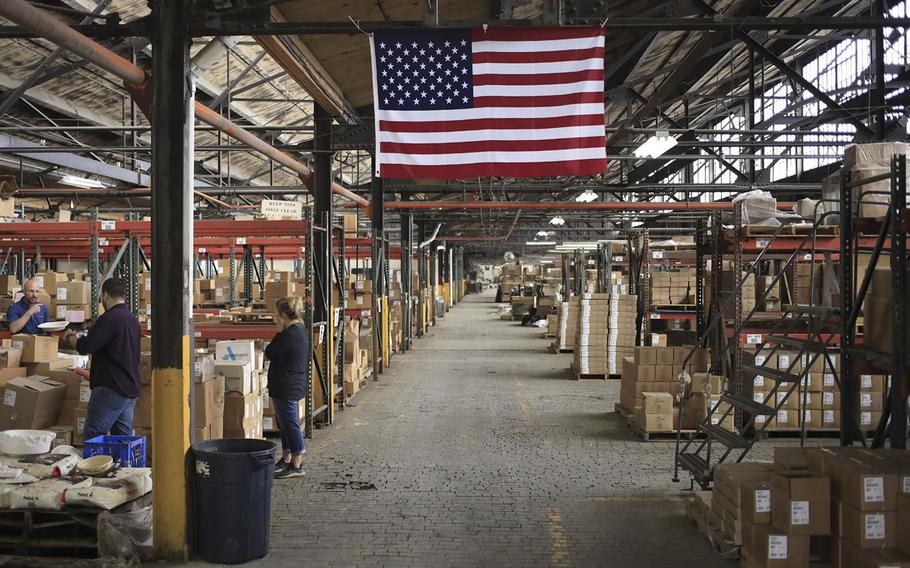
A U.S. flag in a warehouse at the Fiesta Tableware Co. factory in Newell, West Virginia, as seen on July 22, 2021. (Luke Sharrett/Bloomberg )
Stars and Stripes is making stories on the coronavirus pandemic available free of charge. See more stories here. Sign up for our coronavirus newsletter here. Please support our journalism with a subscription.
Millions of workers are still missing from the U.S. labor force three years after Covid-19 surfaced, and economists are scratching their heads as to how big the gap actually is and where all these people went.
One estimate found at least 2.1 million who retired earlier then expected. Another calculated a shortfall of 2 million immigrants at the height of the pandemic. Other research pointed to a million or more out of work because of long Covid.
There's not even an agreement on the overall size of the hole - how many more Americans would be working in 2023 had it not been for the pandemic. That's a problem because officials at the Federal Reserve need to know if Americans are temporarily or permanently out of the labor force so they can set monetary policy, said Anna Wong, chief U.S. economist at Bloomberg Economics.
"It's a very confusing picture," Wong said. "We don't even have good facts to work with."
With the jobless rate at a 53-year low and more employees on payrolls now than there were before the pandemic, how can workers truly be missing?
The labor force is the sum of employed and unemployed people, and some researchers point to an estimate made by Fed economists of how big it should be based on population trends. Assuming people kept working at pre-pandemic rates, they projected a labor force of 168 million by the end of 2022. In reality, the figure was around 165 million, arriving at a shortfall of roughly 3 million.
Things got even muddier earlier this month, when the Labor Department revised its December count of non-farm payrolls by more than 800,000 additional workers. So that 3 million-person hole in the labor force actually may be a third smaller, Wong said.
What gives? Economists acknowledge that data about what motivates workers to drop out is hard to come by, and that trends underpinning their research, like a drop in immigration, have changed over the pandemic's course. Finally, some workers may be counted more than once, like baby boomers who retired because of long Covid.
The labor-force participation rate - the share of the population that is working or looking for work - stands at 62.4%, stubbornly below its pre-Covid level of 63.3%. Had the average rate preceding the pandemic held, the labor force would have had 1.1 million more people in 2022, according to an outlook published by the Congressional Budget Office this month.
Several economists, though, have competing theories about how many missing workers there are and where they went.
Didem Tuzemen, a senior economist at the Kansas City Fed, calculated in a report last October there would be 2.4 million more people in the labor force had participation rates not slipped during the pandemic. Most of the missing workers are older Americans, she noted.
While many older workers initially left the pandemic workforce out of health concerns, others chose to hang their hats for good. Fed Chair Jerome Powell has cited research by the central bank's economists that show "excess retirements" account for more than 2 million of the missing workers, but that hasn't been updated per the Labor Department's revision.
A higher-than-average number of deaths in recent years, mainly from Covid-19, accounts for around 400,000 of the labor-force shortfall, according to the Fed. The pandemic killed many more people - about 1.1 million - but the majority were older and more likely to be out of the workforce.
Harvard University economist Raj Chetty and his colleagues tracked another category of missing workers in a recent paper: low-wage service workers who were displaced from their jobs early in the pandemic and never came back. That's illustrated best by payrolls in sectors like leisure and hospitality and restaurants that still lag their pre-Covid levels.
The researchers zeroed in on affluent areas in big cities like New York where office staff stopped getting haircuts and eating out because they were working from home. Those neighborhoods are the most likely to still be missing low-income workers today.
Elsewhere, University of California at Davis economists found that immigration slowed to a trickle during lockdowns. This led to 2 million fewer working-age immigrants in the U.S. by 2021 than if the historic trend had continued. While that could have made up a big chunk of missing workers at the height of the pandemic, immigration has since picked up and likely plays a smaller role in America's worker shortage today, Davis professor Giovanni Peri said.
Finally, Americans suffering from long Covid is an underappreciated culprit in the missing worker mystery, according to Katie Bach, a nonresident fellow at the Brookings Institution. Last August, she estimated long Covid reduced the U.S. labor force by the equivalent of 1.6 million people when accounting for those who either worked fewer hours or left entirely. That's probably now down to somewhere in the range of 500,000 to 1 million, Bach said.
"I don't have my boxing gloves on, and I won't say that anyone is wrong," said Michael Stepner, an assistant economics professor at the University of Toronto who co-wrote the paper with Chetty. "We all want a simple one-line explanation. But I think this is a puzzle that has many pieces."
Bloomberg's Ben Steverman contributed to this report.